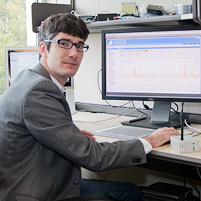Energy Use Awareness

Anthony Rowe, an assistant research professor in the Electrical and Computer Engineering Department, knows exactly how much energy his home appliances use.
"My DVR is the third biggest energy consumer in my apartment today," said Rowe, pointing to a graph on his computer.
He can pull up an energy profile for his refrigerator to make sure it is working correctly and can even turn on his bedroom light from his office.
It's all part of Rowe's research, aimed at generating awareness about energy use.
Rowe's home appliances are all connected to wireless sensor nodes, individual sensors that gather remote information and link to a larger network.
The nodes are little black boxes that function like adaptors, plugging into an outlet and connecting to an appliance. Inside each node are sensors that measure an appliance's energy output while recording the area's environmental conditions like light, temperature and vibration.
The nodes also contain wireless transmitters that send signals to a receiver, which collects and delivers the data to a web interface, called Sensor Andrew Gateway Agent (SAGA). So there you have it: mystery solved.
The sensor nodes are part of CMU's FireFly Wireless Sensor Network, a low-cost and low-power hardware platform that collects and transfers data in real-time. Only in the last two years have Rowe and his collaborators begun developing energy monitoring applications for the FireFly technology with funding from the National Science Foundation.
Right now there are six houses being observed and the data from these homes will reveal important information about energy habits.
"In the future, this technology and the data it collects will be vital in helping utility companies shift peak usage periods for power-hungry appliances," Rowe said.
This would help avoid blackouts and reduce the need for new power plants. Rowe also says the information can also be shared "to educate homeowners about energy waste and encourage them to cut down or divert their usage to off-peak times."
Privacy is of major concern because the sensors are capable of exposing information about lifestyle patterns. A student at the university's CyLab will be investigating this issue.
Collaborators on the project are ECE Professor Raj Rajkumar, Professor Lucio Soibelman and Assistant Professor Mario Berges from the Department of Civil and Environmental Engineering and CEE Department Head and Co-Director of CenSCIR James Garrett. Carnegie Mellon.
Researchers at Carnegie Mellon Portugal are also involved, working on independent research.
Related Links: Electrical & Computer Engineering | Firefly Wireless Sensor Network | Environment at Carnegie Mellon
